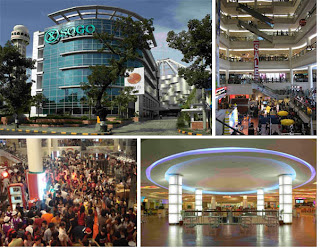As share prices decline over a prolonged period, Mr. Market's hope for a swift recovery becomes weaker and weaker. As Mr. Market despairs, he is going to sell stocks at even lower prices. Everything else remaining equal, this means that we can buy stocks with greater margins of safety from Mr. Market.
However, remember that Mr. Market is a fickle creature. His mood swings are well known. So, although waiting for the market to bottom sounds like a great idea, it is only possible to really call the bottom once it has come and gone. Therefore, I made a list of stocks which I would like to buy more of, including the prices which might be good to do so at.
Mr. Market's negativity is centred around expectations of a reduction in global liquidity and increase in interest rates. However, such concerns are really premature since what is really going to happen is a reduction in the growth of global liquidity and, by Ben Bernanke's admission, any increase in short term interest rates is farther into the future.
This suggests that S-REITs which are fundamentally sound will continue to deliver, distributing the income which I have become accustomed to receiving. With prices 15 to 20% lower than the peaks achieved not too long ago, valuations are more reasonable now although I would not say compelling.
So, which stocks have I been accumulating in the current correction?
Marco Polo Marine
I bought more shares of Marco Polo Marine at $0.37 to $0.375. I really like the news that the company bought a new 9,000 BHP AHTS at a bargain from a distressed yard. It would take the company's shipyard 18 months to build one from scratch and buying this AHTS allows Marco Polo Marine to more quickly meet market demands in Indonesia.

"
Given the robust demand for OSVs and the gradual and consistent rise in daily charter rates experienced over the past few months, the Group expects its offshore business to continue to spearhead the growth of its overall chartering revenue," Mr. Sean Lee, CEO, Marco Polo Marine.
Marco Polo Marine's listed Indonesian subsidiary has another 2 AHTS on order and these are being built in their own shipyard. Expected to be delivered sometime in 2014, Marco Polo Marine is likely to register much stronger performance next year. Buying at $0.37 to $0.375 is also a bargain as it is at >15% discount to NAV.
SPH
I got more shares of SPH at $4.22. That is some 10% lower than the top of $4.68 touched in early April a couple of months ago. Volume has also been reducing as price weakened. Sellers are less enthusiastic but without strong buying interest, price could drift lower.
Well, as Mr. Market would have it, SPH's share price went even lower today, closing at $4.16, the low of the day. The optimism surrounding SPH's plan to bundle Paragon and Clementi Mall into a REIT seems to have evaporated, hinting at the pessimism surrounding all things S-REITs at the moment.

At this time, remind ourselves that the listing of SPH REIT is a good thing for SPH's shareholders. It strengthens SPH's balance sheet without really compromising its revenue stream from its real estate holdings. SPH will see its gearing level reducing to almost zero.
With the promise of a special dividend of 18c per share, post SPH REIT's listing, there is a cushion against further decline in share price which, using Fibo retracement lines, will find support at:
$4.11 (123.6%)
$4.04 (138.2%)
$3.99 (150.0%)
$3.93 (161.8%)
Remember that TA shows where the supports are. There is no promise that the supports will be tested.
Certainly, if the opportunities should present themselves, offers at $3.93 or $3.99 a share cum special dividend of 18c would be more attractive propositions.
NeraTel
This is a stock which I got in at 40.5c a share some time back. This was after the failed take over bid by ST Engineering. I didn't do much research on this company on my own. Neither did I have any experience with it. Instead, I relied on some advice by a very good friend who has been a shareholder for years.

This is a net cash company and has a record of paying consistent and meaningful dividends. Its last payout was 4c a share with an EPS of 5c. At today's closing price of 61c, we are looking at a dividend yield of 6.56% which is very decent. With its recurring revenue streams, dividends are probably sustainable.
So, I bought more shares of NeraTel as its share price retreated from a high of 69.5c. With buy prices of 60c to 63c, the dividend yields are from 6.35% to 6.67%. Any further weakness and a possible test of the rising 200d MA (approximating 57.5c now) for support would see me increasing my long exposure.
Certainly, I cannot tell how share prices will move tomorrow. So, I cannot tell if my additional investments made recently will result in paper losses but I can tell if I have made relatively sound decisions.
By looking at charts, I can tell where supports are expected to be found. So, I can tell where I might be adding to my long positions, given the chance.
Some things we know. Some things we don't.
I know, for sure, that we should have a plan and we should stick to it.
Related posts:
1.
Spotlight on Marco Polo Marine.
2.
SPH: A REIT investment.
3.
REITs: When to buy?
4.
REITs: Are we asking the right questions?
5.
Be cautious climbing the S-REIT tree.
6.
Have a plan, your own plan.




































